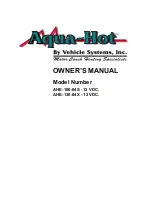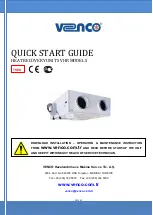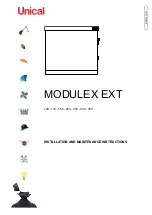
Emergency Procedures
10. Emergency Procedures
10.1 Emergency stop
In the event that the system must be stopped immediately,
the lift system has an emergency stop button located on
the door just below the touch screen (see the “Component
identification” section on page 8). It is red in color and
simply needs to be pushed in on any lift unit to halt a
vehicle lift or lowering that may be in progress. The normal
emergency stop condition will communicate with all lift
units synchronized in the system to halt all lift units at
once. After the situation is assessed, and it is determined
that it is safe to continue lifting or lowering, the emergency
stop button originally pushed in can be pulled back out
and the
RESET
button pushed to reset the system. The
RESET
button must be pushed on the lift unit where the
emergency stop button was activated
.
In the unlikely event that the system would lose
communication at the same time an emergency stop
button is pressed and a lift unit is still moving, simply press
the emergency stop button on the lift unit that is still
moving. If this fails to stop the lift unit, turn the master
on/off switch, located on the left side of the control
enclosure (Fig. 2, Pos. 3), to the
OFF
position. If this is the
case, then the motor starter solenoid has likely welded
shut and will have to be replaced before manual lowering
can occur. Contact the manufacturer for instructions on
replacing the motor starter solenoid.
10.2 Manual lowering
Manual operation is intended for use when the
normal controls are not functioning and is NOT to
be used for normal operation
.
Any time the controls are found to not be functioning while
a vehicle is already raised, the vehicle may be lowered to
the ground using the following steps
:
1.
Open the door on each lift unit. The door is held in place
by a latch on the right side
.
2.
Station a person at each lift unit
.
CML Series | 28 | en
2.
Station a person at each lift unit
.
2.
Each person must one at a time hold the manual
raise/lower toggle switch down (Fig. 17). No motion
should occur yet. If a lift unit lowers, release all
manual raise/lower toggle switches, then verify all
needle valves are closed (i.e., turned completely
clockwise)
.
Fig. 17: Manual controls
1
Needle valve
2
Manual raise/lower toggle switch
3
Manual raise push button
4
Oil fill plug
5
Hydraulic reservoir
3.
Each person should slowly open the needle valve
located on the power unit to begin descent while
holding manual raise/lower toggle switch down (Fig.
17)
.
5.
Coordinate the rate of lowering by adjusting the needle
valve—counterclockwise is FASTER and
clockwise is SLOWER
.
Be sure to close all needle valves prior to the next use
.
If one or more lift unit(s) does not move down initially, it
may be resting on the down stop catch pawl. Fully close
the needle valve and slightly raise the carriage to clear the
down stop catch pawl. The carriage is manually raised by
pushing and holding the manual raise push button while
also pushing up on the manual raise/lower toggle switch.
Once carriage is clear of the down stop catch pawl,
lowering can resume
.
Summary of Contents for CML-7
Page 38: ...Maintenance Chart CML Series 38 en Action Date Details Person responsible...
Page 39: ...en 39 CML Series Notes 16 Notes...
Page 40: ...Notes CML Series 37 Notes CML Series 40 en...
Page 41: ...en 41 CML Series Notes...
Page 42: ...en 42 CML Series Notes...
Page 43: ...en 43 CML Series Notes...
















































